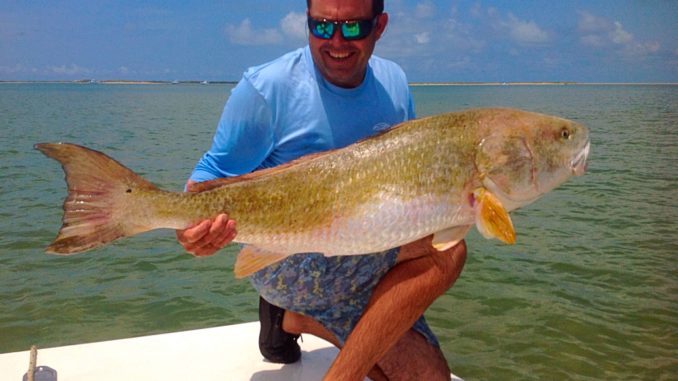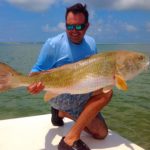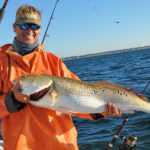
Huge, adult drum move to Cape Lookout’s shoals for October feeding frenzy
By October, most inshore saltwater species will have moved through the inlets along North Carolina’s northern coast and into the ocean, especially after the water begins to cool.
That includes red drum, in particular “old” drum that can reach 40 to 50 inches long and weigh almost a pound per inch.
Smaller redfish often remain in the marshes, waiting on menhaden and finger mullet to be pulled past their noses, and to avoid porpoises.
The northern end of the red drum’s range includes Chesapeake Bay southward, particularly Pamlico Sound. When those fish migrate through Oregon, Hatteras and Drum inlets, they travel south, they hug the eastern shoreline, then turn to follow the Cape Lookout shoals offshore.
“The big drum that have been back inside move around Cape Lookout shoals out to (about) 11 miles off the beach,” said Noah Lynk, a Harkers Island guide (252-342-6911). “We go off the beach and look for diving gannets or pelicans. They’re feeding on shad the drum attack and force to the surface.”
The water depth at the shoals is 6 to 10 feet, ideal for redfish and baitfish.
“Surf anglers also catch them that time of year, and some might be at the (Cape Lookout) rock jetty,” Lynk said.
Finding diving gannets assures anglers that drum are in the water, in a feeding mood and primed to hit lures. Fishing from a boat provides more action than standing in the surf, soaking mullet strips on the bottom and hoping an old drum will follow the scent trail and bite.
“A favorite spot to hook into old drum is Shark Island,” Lynk said, describing a spot that isn’t exactly an island but a sand bar that appears and disappears at times off Morehead City. It builds up to a few feet above water, then gets flattened by big storms, especially hurricanes.
“A hurricane washed it away a few years ago, then it built back up to three small islands that have combined into one,” he said.
For big reds, Lynk likes a 6- to 61/2-foot rod with a 4500 series reel spooled with a couple hundred yards of 18-pound braid and 3 feet of 30- to 40-pound fluorocarbon or monofilament leader. He casts 4-, 6- and sometimes even 7-inch soft-plastic baits, mostly paddletails or Flukes, in menhaden colors.
“They’ll hit spoons, too,” Lynk said.
The idea is to land a drum as quickly as possible to prevent its exhaustion, so a medium-strength rod is needed.
“You can find reds all the way to the Knuckle Buoy (the end of the shoals),” he said.
Rain suits may be needed from mid-October as the weather dictates. Having a working knowledge of the shoals’ most-used cut-through, the Slot, is key because the route often changes and tow boats may not be able to reach anglers stranded on a beached fishing platform.






Be the first to comment